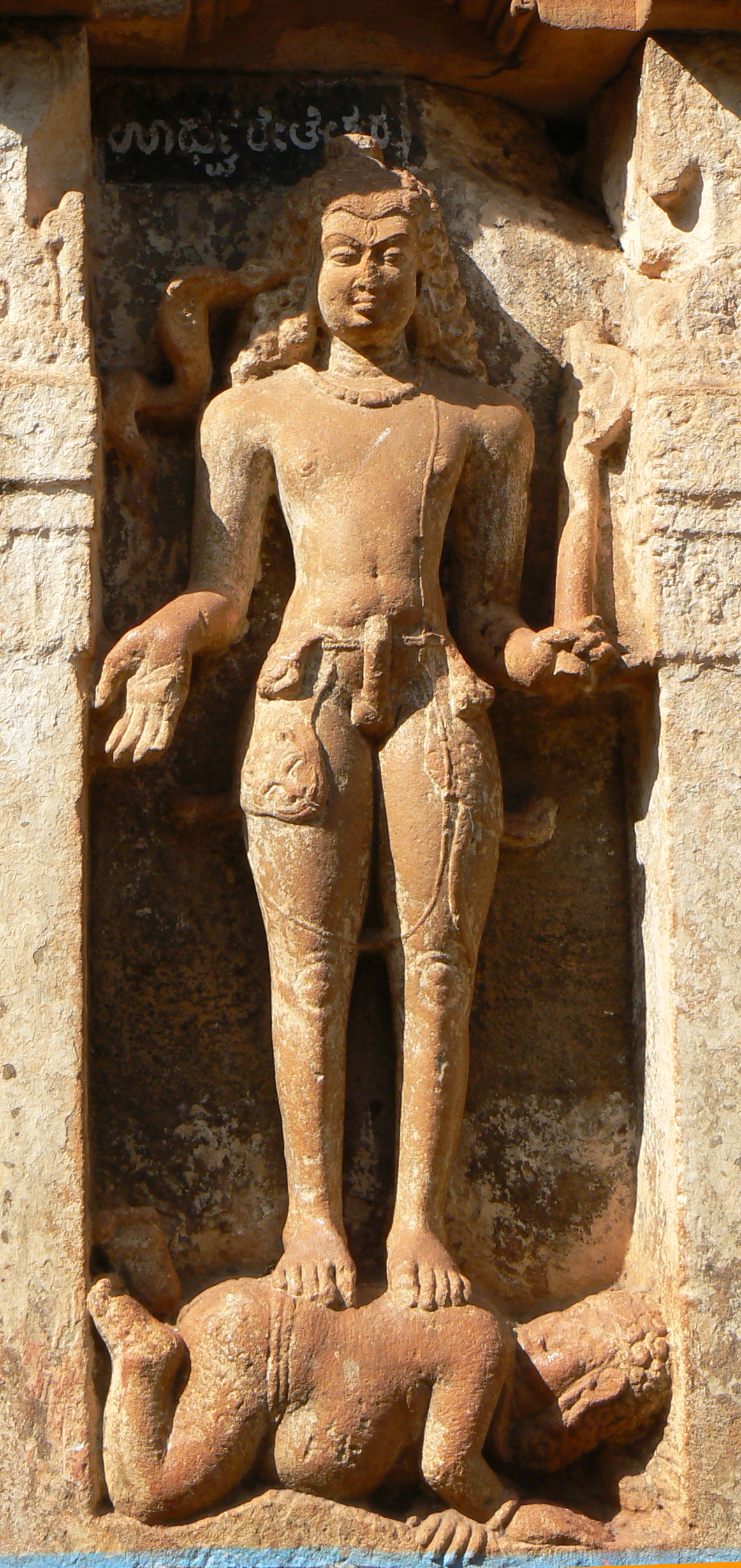|
Pasupata
Pashupata Shaivism (, sa, पाशुपत) is the oldest of the major Shaivite Hindu schools. The mainstream which follows Vedic Pasupata penance are 'Maha Pasupatas' and the schism of 'Lakula Pasupata' of Lakulisa. There is a debate about pioneership of this schism and the Goan school of Nakulish darshan believes that Nakulish was pioneer and Lakulish and Patanjalinath were his disciples while Gujarat school believes that Nakulish and Lakulish are one. Sarvadarśanasaṅgraha written by Vidyaranya (sometimes also known as Madhavacharya) mentions it as "Nakulish Darshan" not as "Lakulish Darshan". Both sub schools are still active in their own areas. The philosophy of the Pashupata sect was systematized by also called Nakulīśa) in the 2nd century CE. The main texts of the school are '' '' with Kauṇḍinya's ', and ' with Bhāsarvajña's '. Both texts were discovered only in the twentieth century. Prior to that, the major source of information on this sect was a chapter d ... [...More Info...] [...Related Items...] OR: [Wikipedia] [Google] [Baidu] |
Lakulisha
Lakulisha ( sa, लकुलीश ) (Etymology: लगुड (staff) or लकुट (mace) + ईश (lord) = meaning, the lord with a staff or mace or club or stick) was a prominent Shaivite revivalist, reformist and preceptor of the doctrine of the Pashupatas, one of the oldest sects of Shaivism. According to some scholars, Lakulisha is the founder of the Pashupata sect. While, another section argues that the Pashupata doctrine was already in existence before Lakulisha, and he was only its first formal preceptor. According to a tradition stated in the ''Linga Purana'', Lakulisha is considered as the 28th and the last avatar of Shiva and the propounder of Yoga system. According to the same tradition, Lakulisha had four disciples, viz., Kaurushya, Garga, Mitra and Kushika. According to another tradition mentioned in the ''Avanti Khanda'' of the ''Skanda Purana'', Lakulisha and his four disciples while passing Mahakalavana, installed a linga at that place, which was then known ... [...More Info...] [...Related Items...] OR: [Wikipedia] [Google] [Baidu] |
Indian Philosophy
Indian philosophy refers to philosophical traditions of the Indian subcontinent. A traditional Hindu classification divides āstika and nāstika schools of philosophy, depending on one of three alternate criteria: whether it believes the Vedas as a valid source of knowledge; whether the school believes in the premises of Brahman and Atman; and whether the school believes in afterlife and Devas. There are six major schools of Vedic philosophy— Nyaya, Vaisheshika, Samkhya, Yoga, Mīmāṃsā and Vedanta, and five major heterodox (sramanic) schools—Jain, Buddhist, Ajivika, Ajñana, and Charvaka. However, there are other methods of classification; Vidyaranya for instance identifies sixteen schools of Indian philosophy by including those that belong to the Śaiva and Raseśvara traditions.Cowell and Gough, p. xii.Nicholson, pp. 158-162. The main schools of Indian philosophy were formalised and recognised chiefly between 500 BCE and the late centuries of the Common ... [...More Info...] [...Related Items...] OR: [Wikipedia] [Google] [Baidu] |
Shaivism
Shaivism (; sa, शैवसम्प्रदायः, Śaivasampradāyaḥ) is one of the major Hindu traditions, which worships Shiva as the Supreme Being. One of the largest Hindu denominations, it incorporates many sub-traditions ranging from devotional dualistic theism such as Shaiva Siddhanta to yoga-orientated monistic non-theism such as Kashmiri Shaivism.Ganesh Tagare (2002), The Pratyabhijñā Philosophy, Motilal Banarsidass, , pages 16–19 It considers both the Vedas and the Agama texts as important sources of theology.Mariasusai Dhavamony (1999), Hindu Spirituality, Gregorian University and Biblical Press, , pages 31–34 with footnotesMark Dyczkowski (1989), The Canon of the Śaivāgama, Motilal Banarsidass, , pages 43–44 Shaivism developed as an amalgam of pre-Vedic religions and traditions derived from the southern Tamil Shaiva Siddhanta traditions and philosophies, which were assimilated in the non-Vedic Shiva-tradition. In the process of Sanskritisa ... [...More Info...] [...Related Items...] OR: [Wikipedia] [Google] [Baidu] |
Rudra
Rudra (; sa, रुद्र) is a Rigvedic deity associated with Shiva, the wind or storms, Vayu, medicine, and the hunt. One translation of the name is 'the roarer'. In the Rigveda, Rudra is praised as the 'mightiest of the mighty'. Rudra means "who eradicates problems from their roots". Depending upon the periodic situation, Rudra can mean 'the most severe roarer/howler' (could be a hurricane or tempest) or 'the most frightening one'. This name appears in the Shiva Sahasranama, and R. K. Sharma notes that it is used as a name of Shiva often in later languages. The ''Shri Rudram'' hymn from the Yajurveda is dedicated to Rudra and is important in the Shaivism sect.For an overview of the Śatarudriya see: . In Prathama Anuvaka of Namakam ( Taittiriya Samhita 4.5), Sri Rudram the 'mightiest of the mighty' Rudra, is revered as ''Sadasiva (meaning 'mighty Shiva')'' and Mahadeva. Sadashiva is the Supreme Being, Lord Paramashiva in the Mantra marga Siddhanta sect of Shaiv ... [...More Info...] [...Related Items...] OR: [Wikipedia] [Google] [Baidu] |
Movements In Ancient Indian Philosophy
Movement may refer to: Common uses * Movement (clockwork), the internal mechanism of a timepiece * Motion, commonly referred to as movement Arts, entertainment, and media Literature * "Movement" (short story), a short story by Nancy Fulda * ''The Movement'' (comics), a comic book by Gail Simone and Freddie Williams II * "Movement (운동, 運動)", a poem by Yi-sang Music Groups and labels * Movement (band), an Australian soul/ambient band * Movements (band), an American post-hardcore band Albums and EPs * ''Movement'' (9mm Parabellum Bullet album) * ''Movement'' (EP), an EP by BT * ''Movement'' (Joe Harriott album), or the title track * ''Movement'' (Inhale Exhale album) * ''Movement'' (New Order album) * ''Movement'' (The Gossip album) * ''Movements'' (album), by Booka Shade Songs * "Movement" (LCD Soundsystem song), 2004 * "Movement" (Kompany song), 2019 * "Movement" (Hozier song), 2019 * "Movement", a 1998 song by The Black Eyed Peas from ... [...More Info...] [...Related Items...] OR: [Wikipedia] [Google] [Baidu] |
Shaiva Siddhanta
Shaiva Siddhanta () (Tamil: சைவ சித்தாந்தம் "Caiva cittāntam") is a form of Shaivism that propounds a dualistic philosophy where the ultimate and ideal goal of a being is to become an enlightened soul through Shiva's grace. It draws primarily on the Tamil devotional hymns written by Shaiva saints from the 5th to the 9th century, known in their collected form as '' Tirumurai''. Meykandadevar (13th century) was the first systematic philosopher of the school. The normative rites, cosmology and theology of Shaiva Siddhanta draw upon a combination of Agamas and Vedic scriptures. This tradition is thought to have been once practiced all over India. However the Muslim subjugation of North India restricted Shaiva Siddhanta to the south, where it merged with the Tamil Saiva movement expressed in the bhakti poetry of the Nayanmars.Flood, Gavin. D. 1996. An Introduction to Hinduism. P.168 It is in this historical context that Shaiva Siddhanta is commonl ... [...More Info...] [...Related Items...] OR: [Wikipedia] [Google] [Baidu] |
Kashmir Shaivism
Kashmir Shaivism or Trika Shaivism, is a nondualist tradition of Shaiva-Shakta Tantra which originated sometime after 850 CE. Since this tradition originated in Kashmir it is often called "Kashmiri Shaivism". It later went on to become a pan-Indian movement termed "Trika" (lit. The Trinity) by its great exegete, Abhinavagupta, and particularly flourished in Odisha and Maharashtra.Wallis, Christopher; Tantra Illuminated, chapter II, The History of Śaiva Tantra Defining features of the Trika tradition are its idealistic and monistic '' Pratyabhijna'' ("Recognition") philosophical system, propounded by Utpaladeva (c. 925–975 CE) and Abhinavagupta (c. 975–1025 CE), and the centrality of the three goddesses Parā, Parāparā, and Aparā. While Trika draws from numerous Shaiva texts, such as the Shaiva Agamas and the Shaiva and Shakta Tantras, its major scriptural authorities are the ''Mālinīvijayottara Tantra'', the ''Siddhayogeśvarīmata'' and the ''Anāmaka-tantra ... [...More Info...] [...Related Items...] OR: [Wikipedia] [Google] [Baidu] |
Spiritual Practices
A spiritual practice or spiritual discipline (often including spiritual exercises) is the regular or full-time performance of actions and activities undertaken for the purpose of inducing spiritual experiences and cultivating spiritual development. A common metaphor used in the spiritual traditions of the world's great religions is that of walking a path. Therefore, a spiritual practice moves a person along a path towards a goal. The goal is variously referred to as salvation, liberation or union (with God). A person who walks such a path is sometimes referred to as a wayfarer or a pilgrim. Religion Abrahamic religions Judaism Jewish spiritual practices may include prayer (including the Shema and Amidah), reciting blessings, Jewish meditation, Torah study, following dietary laws of kashrut, observing Shabbat, fasting, practices of teshuvah, giving tzedakah, and performing deeds of loving-kindness. ''Kavanah'' is the directing of the heart to achieve higher contemplativ ... [...More Info...] [...Related Items...] OR: [Wikipedia] [Google] [Baidu] |
Transmigration Of The Soul
Reincarnation, also known as rebirth or transmigration, is the philosophical or religious concept that the non-physical essence of a living being begins a new life in a different physical form or body after biological death. Resurrection is a similar process hypothesized by some religions, in which a soul comes back to life in the same body. In most beliefs involving reincarnation, the soul is seen as immortal and the only thing that becomes perishable is the body. Upon death, the soul becomes transmigrated into a new infant (or animal) to live again. The term transmigration means passing of soul from one body to another after death. Reincarnation (''Punarjanma'') is a central tenet of the Indian religions such as Buddhism, Hinduism, Jainism, and Sikhism; as well as certain Paganist religious groups, although there are Hindu and Buddhist groups who do not believe in reincarnation, instead believing in an afterlife. In various forms, it occurs as an esoteric belief in many str ... [...More Info...] [...Related Items...] OR: [Wikipedia] [Google] [Baidu] |
Ātman (Hinduism)
''Ātman'' (; sa, आत्मन्) is a Sanskrit word that refers to the (universal) Self or self-existent essence of individuals, as distinct from ego ('' Ahamkara''), mind ('' Citta'') and embodied existence ('' Prakṛti''). The term is often translated as soul, but is better translated as "Self," as it solely refers to pure consciousness or witness-consciousness, beyond identification with phenomena. In order to attain moksha (liberation), a human being must acquire self-knowledge ('' Atma Gyaan or Brahmajnana''). ''Atman'' is a central concept in the various schools of Indian philosophy, which have different views on the relation between ''Atman'', individual Self ('' Jīvātman''), supreme Self ('' Paramātmā'') and, the Ultimate Reality ('' Brahman''), stating that they are: completely identical ( Advaita, Non-Dualist), completely different ( Dvaita, Dualist), or simultaneously non-different and different ( Bhedabheda, Non-Dualist + Dualist). The six orthodo ... [...More Info...] [...Related Items...] OR: [Wikipedia] [Google] [Baidu] |
Classical Element
Classical elements typically refer to earth, water, air, fire, and (later) aether which were proposed to explain the nature and complexity of all matter in terms of simpler substances. Ancient cultures in Greece, Tibet, and India had similar lists which sometimes referred, in local languages, to "air" as "wind" and the fifth element as "void". These different cultures and even individual philosophers had widely varying explanations concerning their attributes and how they related to observable phenomena as well as cosmology. Sometimes these theories overlapped with mythology and were personified in deities. Some of these interpretations included atomism (the idea of very small, indivisible portions of matter), but other interpretations considered the elements to be divisible into infinitely small pieces without changing their nature. While the classification of the material world in ancient Indian, Hellenistic Egypt, and ancient Greece into Air, Earth, Fire and Water wa ... [...More Info...] [...Related Items...] OR: [Wikipedia] [Google] [Baidu] |






